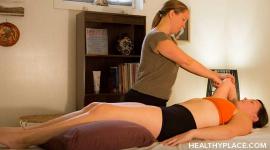What Is Osteopathic Medicine?

There is scientific evidence that osteopathic medicine is beneficial for low back pain and other neuromusculoskeletal problems. Learn more about osteopathic medicine.
Before engaging in any complementary medical technique, you should be aware that many of these techniques have not been evaluated in scientific studies. Often, only limited information is available about their safety and effectiveness. Each state and each discipline has its own rules about whether practitioners are required to be professionally licensed. If you plan to visit a practitioner, it is recommended that you choose one who is licensed by a recognized national organization and who abides by the organization's standards. It is always best to speak with your primary health care provider before starting any new therapeutic technique.
Background
Andrew Taylor Still, who was originally trained as a doctor of medicine, founded the discipline of what is now known as osteopathic medicine in 1874. Dr. Still started the first college of osteopathic medicine in 1892 in Kirksville, Missouri. He sought an holistic approach to treating illness and promoting health by enhancing the body's natural healing powers. His approach emphasized the relationship between body structure and function, and it aimed to focus on the whole patient (mind, body and soul), rather than on symptoms.
Today, osteopathic medicine in the United States combines conventional medical practices with osteopathic manipulation, physical therapy and education about healthful posture and body positioning. With osteopathic manipulation, osteopathic physicians use their hands to diagnose injury and illness and to administer manual treatments. Doctors of osteopathic medicine receive similar training as doctors of medicine (MD's), with additional training in osteopathic and holistic medicine. Osteopathic physicians perform all aspects of medicine, surgery and emergency medicine, and they can prescribe drugs. Many doctors of osteopathic medicine belong to the American Medical Association, as well as to the American Osteopathic Association. Osteopathic medicine is sometimes confused with chiropractic, as both use spinal manipulation to treat patients.
Osteopathic physicians often focus on the neuromusculoskeletal system and perform manipulations to treat a wide range of problems. Doctors of osteopathic medicine are trained to evaluate the body by taking a patient's health history, focusing not only on health problems but on lifestyle issues as well. The practice of osteopathic medicine may involve massage, mobilization and spinal manipulation. Osteopathic physicians traditionally believe that the primary role of the health care provider is to facilitate the body's inherent ability to heal itself, that the structure and function of the body are closely related and that problems in one organ affect other parts of the body. The traditional osteopathic view is that perfect alignment of the musculoskeletal system eliminates obstructions in blood and lymphatic flow, which in turn maximizes health. To ensure perfect alignment, a range of manipulative techniques have been developed. Examples include high-velocity thrusts, myofascial (muscle tissue) release, muscle energy techniques, counter strain, craniosacral therapies and lymphatic drainage stimulation.
Theory
Dr. Still believed that the continuum between health and illness was primarily influenced by the soundness and mechanical functioning of the body's structures. In contrast to conventional medicine, which historically focused on the individual systems of the body, osteopathic medicine emphasizes the interactive relationships between all body systems, with a continually shifting balance to maintain a state of health.
Evidence
In the United States, osteopathic physicians treat many conditions with the same techniques as MD's. Many of these techniques are considered standard of care and have firmly established scientific support. Scientists have also studied osteopathic medicine for the following health problems:
Back pain
There is growing scientific evidence that the osteopathic approach may be beneficial for low back pain, especially shortly after pain begins. One trial comparing osteopathic medicine with "standard care" showed that both therapies produced similar results. Another study reported that osteopathic patients use fewer drugs (pain relievers, anti-inflammatory drugs and muscle relaxants) and less physical therapy than do patients receiving standard care. In a controlled trial of osteopathic manipulative treatment (compared with "sham manipulation"), no significant benefits were found. Additional research is needed to clarify these findings.
Ankle injury
Preliminary evidence suggests that osteopathic manipulation in the emergency department may have a beneficial effect in the management of acute ankle injuries. Further research is necessary to confirm these findings.
Asthma
One study of children with asthma found osteopathic manipulative treatment to be beneficial for improving peak flow rates. Further research is needed to confirm these findings.
Tennis elbow (epicondylitis)
There is early evidence from one randomized controlled trial to support the use of an osteopathic approach for epicondylopathia humeri radialis. Further study is needed before a recommendation can be made.
Knee or hip joint replacement
It remains unclear if osteopathic manipulative treatment is beneficial after knee or hip replacement surgery. Preliminary research suggests osteopathic manipulative treatment may reduce pain, improve ambulation (ability to walk) and increase rehabilitation. However, one randomized controlled trial suggests a lack of benefit in rehabilitation. Further research is needed to clarify this evidence.
Other
There is a growing body of research of osteopathic manipulation for a wide range of conditions. There is promising early evidence in a number of areas, including the treatment of asthma, chronic obstructive pulmonary disease and emphysema, depression, fibromyalgia, menstrual pain, neck pain, pneumonia and thoracic outlet syndrome; postoperative care; and overall quality of life. Additional research is currently under way.
Unproven Uses
Osteopathic manipulation has been suggested for many additional uses, based on tradition or on scientific theories. However, most of these uses have not been thoroughly studied in humans, although there is an increasing amount of research in this area.
| Amblyopia (poor vision) Bell's palsy Cerebral palsy Chest pain Ear infections Emergency medicine Epilepsy Erectile dysfunction Headache, including migraine Heartburn Hepatitis High blood pressure Immune response Lumbar disc herniation | Mononucleosis Neuritis (inflammation of a nerve) Pain during labor Parkinson's disease Postoperative musculoskeletal recovery Pregnancy-related complications Premenstrual syndrome Prenatal care Radiation fibrosis Rheumatoid arthritis Sexual dysfunction Sinus inflammation or infection Spastic cerebral palsy Whiplash |
Potential Dangers
The practice of osteopathic manipulation may be associated with a risk of spinal cord trauma or stroke. People with osteoporosis, tumors, infections, severe rheumatoid arthritis, blood vessel aneurysms, artery dissections, clogging of the arteries of the neck, bone cancer, bone or joint infections or bleeding disorders should avoid osteopathic manipulation. Osteopathic manipulation should not replace other more proven treatments for potentially severe conditions.
Summary
Osteopathic physicians in the United States combine conventional medical practices with osteopathic manipulation, physical therapy and education about healthful posture and body positioning. The osteopathic approach may play a beneficial role in the treatment of low back pain. Osteopathic manipulation has been suggested for many conditions; this is a growing area of research. Osteopathic manipulation should be performed only by a qualified osteopathic physician. Osteopathic manipulation may be associated with adverse effects such as damage to the spinal cord or stroke. It should be avoided by patients with osteoporosis, tumors or bleeding disorders.
The information in this monograph was prepared by the professional staff at Natural Standard, based on thorough systematic review of scientific evidence. The material was reviewed by the Faculty of the Harvard Medical School with final editing approved by Natural Standard.
Resources
- Natural Standard: An organization that produces scientifically based reviews of complementary and alternative medicine (CAM) topics
- National Center for Complementary and Alternative Medicine (NCCAM): A division of the U.S. Department of Health & Human Services dedicated to research
Selected Scientific Studies: Osteopathic Medicine
Natural Standard reviewed more than 440 articles to prepare the professional monograph from which this version was created.
Some of the more recent English-language studies are listed below:
- Andersson GB, Lucente T, Davis AM, et al. A comparison of osteopathic spinal manipulation with standard care for patients with low back pain. N Engl J Med 1999;341(19):1426-1431.
- Bratzler DW. Osteopathic manipulative treatment and outcomes for pneumonia. J Am Osteopath Assoc 2001;101(8):427-428.
- Colli R, Biagiotti I, Sterpa A. Osteopathy in neonatology. Pediatr Med Chir 2003;Mar-Apr, 25(2):101-105.
- Duncan B, Barton L, Edmonds D, et al. Parental perceptions of the therapeutic effect from osteopathic manipulation or acupuncture in children with spastic cerebral palsy. Clin Pediatr (Phila) 2004;43(4):349-353.
- Eisenhart AW, Gaeta TJ, Yens DP. Osteopathic manipulative treatment in the emergency department for patients with acute ankle injuries. J Am Osteopath Assoc 2003;103(9):417-421.
- Gamber RG, Shores JH, Russo DP, et al. Osteopathic manipulative treatment in conjunction with medication relieves pain associated with fibromyalgia syndrome: results of a randomized clinical pilot project. J Am Osteopath Assoc 2002;102(6):321-325.
- Geldschlager S. Osteopathic versus orthopedic treatments for chronic epicondylopathia humeri radialis: a randomized controlled trial. Forsch Komplementarmed Klass Naturheilkd 2004;11(2):93-97.
- Guiney PA, Chou R, Vianna A, et al. Effects of osteopathic manipulative treatment on pediatric patients with asthma: a randomized controlled trial. J Am Osteopath Assoc 2005;105(1):7-12.
- Gonzalez-Hernandez T, Balsa A, Gonzalez-Suquinza I, et al. Comparison of conventional physiotherapy and osteopathy for the treatment of chronic neck pain. Arthritis Rheum 1999;42(9):S270.
- Hing WA, Reid DA, Monaghan M. Manipulation of the cervical spine. Man Ther 2003;Feb, 8(1):2-9.
- Jarski RW, Loniewski EG, Williams J, et al. The effectiveness of osteopathic manipulative treatment as complementary therapy following surgery: a prospective, match-controlled outcome study. Altern Ther Health Med 2000;6(5):77-81.
- King HH, Tettambel MA, Lockwood MD, et al. Osteopathic manipulative treatment in prenatal care: a retrospective case control design study. J Am Osteopath Assoc 2003;103(12):577-582.
- Licciardone J, Gamber R, Cardarelli K. Patient satisfaction and clinical outcomes associated with osteopathic manipulative treatment. J Am Osteopath Assoc 2002;102(1):13-20.
- Licciardone JC, Stoll St, Cardarelli KM, et al. A randomized controlled trial of osteopathic manipulative treatment following knee or hip arthroplasty. J Am Osteopath Assoc 2004;104(5):193-202.
- Licciardone JC, Stoll ST, Fulda KG, et al. Osteopathic manipulative treatment for chronic low back pain: a randomized controlled trial. Spine 2003;28(13):1355-1362.
- Licciardone JC, Gamber RG, Russo DP. Quality of life in referred patients presenting to a specialty clinic for osteopathic manipulative treatment. J Am Osteopath Assoc 2002;102(3):151-155.
- Martin RB. Osteopathic approach to sexual dysfunction: holistic care to improve patient satisfaction and prevent mortality and morbidity. J Am Osteopath Assoc 2004;104(1 Suppl 1):S1-S8.
- Noll DR, Degenhardt BF, Stuart MK, et al. The effect of osteopathic manipulative treatment on immune response to the influenza vaccine in nursing home residents: a pilot study. Altern Ther Health Med 2004;10(4):74-76.
- Plotkin BJ, Rodos JJ, Kappler R, et al. Adjunctive osteopathic manipulative treatment in women with depression: a pilot study. J Am Osteopath Assoc 2001;101(9):517-523.
- Ray AM, Cohen JE, Buser BR. Osteopathic emergency physician training and use of osteopathic manipulative treatment. J Am Osteopath Assoc 2004;104(1):15-21.
- Spiegel AJ, Capobianco JD, Kruger A, Spinner WD. Osteopathic manipulative medicine in the treatment of hypertension: an alternative, conventional approach. Heart Dis 2003;Jul-Aug, 5(4):272-278.
- Sommerfeld P, Kaider A, Klein P. Inter- and intraexaminer reliability in palpation of the "primary respiratory mechanism" within the "cranial concept". Man Ther 2004;Feb, 9(1):22-29.
- Sullivan C. Introducing the cranial approach in osteopathy and the treatment of infants and mothers. Complement Ther Nurs Midwifery 1997;Jun, 3(3):72-76.
- Vick DA, McKay C, Zengerle CR. The safety of manipulative treatment: review of the literature from 1925 to 1993. J Am Osteopath Assoc 1996;96(2):113-115.
- Waldman P. Osteopathy: an aid to the healing process. Prof Nurse 1993;Apr, 8(7):452-454.
- Williams N. Managing back pain in general practice: is osteopathy the new paradigm? Br J Gen Pract 1997;Oct, 47(423):653-655.
- Williams NH, Wilkinson C, Russell I, et al. Randomized osteopathic manipulation study (ROMANS): pragmatic trial for spinal pain in primary care. Fam Pract 2003;Dec, 20(6):662-669.
back to: Alternative Medicine Home ~ Alternative Medicine Treatments
APA Reference
Staff, H.
(2008, November 30). What Is Osteopathic Medicine?, HealthyPlace. Retrieved
on 2025, April 18 from https://www.healthyplace.com/alternative-mental-health/treatments/osteopathy


